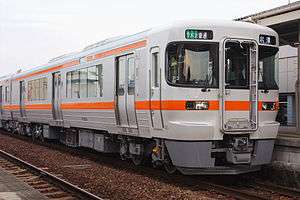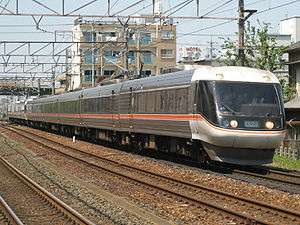KiHa 25
| KiHa 25 | |
|---|---|
|
First-batch set P3 on the Taketoyo Line in March 2011 | |
| In service | March 2011– |
| Manufacturer | Nippon Sharyo |
| Built at | Toyokawa, Aichi |
| Constructed | 2010–2015 |
| Number under construction | 36 vehicles |
| Number built | 26 vehicles (13 sets) |
| Number in service | 26 vehicles (13 sets) |
| Formation | 2 cars per set |
| Fleet numbers | P1–P5, P101-P108, M101-M114 |
| Operator(s) | JR Central |
| Depot(s) | Nagoya |
| Line(s) served | Taketoyo Line, Takayama Main Line, Taita Line, Kisei Main Line |
| Specifications | |
| Car body construction | Stainless steel |
| Car length | 20,100 mm (65 ft 11 in) |
| Width | 2,978 mm (9 ft 9.2 in) |
| Height | 4,020 mm (13 ft 2 in) |
| Floor height | 1,140 mm (3 ft 9 in) |
| Doors | Three pairs per side |
| Maximum speed | 110 km/h (70 mph) |
| Prime mover(s) | C-DMF14HZD (1 per car) |
| Power output | 450 hp (340 kW) |
| Transmission | Hydraulic |
| Bogies | C-DT67 (powered), C-T255 (trailer)[1] |
| Safety system(s) | ATS-PT, ATS-ST[2] |
| Track gauge | 1,067 mm (3 ft 6 in) |
The KiHa 25 (キハ25形) is a diesel multiple unit (DMU) train type operated by the Central Japan Railway Company (JR Central) in Japan, since March 2011. Following electrification of the Taketoyo Line in 2015, they replaced KiHa 40 series DMUs on the Takayama and Taita Lines.[3][4]
Variants
- KiHa 25: 1st-batch 2-car sets in service since March 2011
- KiHa 25-1000: 2nd-batch cold-region 2-car sets in service since 1 December 2014
- KiHa 25-1500: Warm-region 2-car sets
Operations
- Taketoyo Line (since March 2011)
- Takayama Main Line (since March 2015)[5]
- Taita Line
- Kisei Main Line (since 1 August 2015)[6]
- Sangu Line (since 1 August 2015)[6]
Formations
As of 1 April 2015, the fleet consists of 26 cars, formed as five two-car first-batch sets (P1 to P5), and eight two-car second-batch sets (P101 to P108).[7]
KiHa 25-0 series
The 1st-batch sets are formed as follows.[2]
| Designation | Mc1 | Mc2 |
|---|---|---|
| Numbering | KiHa 25-100 | KiHa 25 |
| Weight (t) | 40.0 | 39.3 |
| Capacity (total/seated) | 134/40 | 140/48 |
The KiHa 25-0 cars have a universal access toilet.[1]
 KiHa 25-4 of set P4 in December 2015
KiHa 25-4 of set P4 in December 2015 KiHa 25-104 of set P4 in December 2015
KiHa 25-104 of set P4 in December 2015
KiHa 25-1000 series
The KiHa 25-1000 series sets are formed as follows.[8]
| Designation | Mc1 | Mc2 |
|---|---|---|
| Numbering | KiHa 25-1100 | KiHa 25-1000 |
The KiHa 25-1000 cars have a universal access toilet.[8]
 KiHa 25-1003 of set P103 in October 2014
KiHa 25-1003 of set P103 in October 2014 KiHa 25-1103 of set P103 in October 2014
KiHa 25-1103 of set P103 in October 2014 KiHa 25-1607 of set M107 in May 2016
KiHa 25-1607 of set M107 in May 2016 KiHa 25-1507 of set M107 in May 2016
KiHa 25-1507 of set M107 in May 2016
Exterior
The car bodies are constructed of stainless steel and are based on JR Central's 313 series electric multiple unit design.[9] The beading on the lower bodyside was discontinued on the second-batch units, giving flush body sides.[10] The second-batch units have cushions on the front-end skirts to prevent damage from collisions with deer.[8]
Interior
Seating in the first-batch units (P1 to P5) consists of transverse flip-over seats arranged 2+2 abreast, with interiors based on the 313-1300 series EMU design.[3] The second-batch sets (P101 onward) have longitudinal seating.[8]
History
The first two sets, P1 and P2, were delivered from the Nippon Sharyo factory in Toyokawa to Nagoya on 10 November 2010.[11] The remaining three sets, P3 to P5, were delivered on 23 February 2011.[12]
The type entered service on the Taketoyo Line from 1 March 2011.[13]
A second batch of KiHa 25 series trains is on order by JR Central, with a total of 52 new vehicles scheduled to be introduced between fiscal 2014 and 2015 on the Takayama Main Line, Taita Line, Kisei Main Line, and Sangu Line, at a cost of approximately 12 billion yen, replacing all remaining former JNR-era DMUs, including KiHa 40, KiHa 47, and KiHa 48 types.[14] The new batch of trains will include LED interior lighting.[14]
The first three new second-batch sets were delivered from the Nippon Sharyo factory in Toyokawa in September 2014.[10]
References
- 1 2 "キハ25形気動車" [KiHa 25 DMU]. Japan Railfan Magazine. Vol. 51 no. 599. Japan: Koyusha Co., Ltd. March 2011. pp. 54–56.
- 1 2 Ono, Toshio (May 2011). キハ25形気動車 [KiHa 25 DMU]. Japan Railfan Magazine. Vol. 51 no. 601. Japan: Koyusha Co., Ltd. pp. 82–85.
- 1 2 "JR東海 新型気動車キハ25形を製造" [JR Central introduces new KiHa 25 DMUs]. Tetsudō Daiya Jōhō Magazine. Vol. 40 no. 321. Japan: Kotsu Shimbun. January 2011. p. 73.
- ↑ 新型ディーゼル車公開 [New diesel trains unveiled]. Yomiuri Online (in Japanese). Japan: The Yomiuri Shimbun. 24 December 2010. Retrieved 27 December 2010.
- ↑ 高山本線からキハ40系が引退 [KiHa 40 series withdrawn from Takayama Main Line]. Japan Railfan Magazine Online (in Japanese). Japan: Koyusha Co., Ltd. 2 July 2015. Retrieved 2 July 2015.
- 1 2 紀勢本線・参宮線でキハ11形からキハ25形へ置換え [Switch from KiHa 11 to KiHa 25 on Kisei Main Line and Sangu Line]. Japan Railfan Magazine Online (in Japanese). Japan: Koyusha Co., Ltd. 3 August 2015. Retrieved 2015. Check date values in:
|access-date=(help) - ↑ JR車両のデータバンク [JR Rolling Stock Databank]. Japan Railfan Magazine (in Japanese). Vol. 55 no. 651. Japan: Koyusha Co., Ltd. July 2015. p. Supplement p.20.
- 1 2 3 4 キハ25形2次車 [KiHa 25 2nd-batch DMUs]. Japan Railfan Magazine (in Japanese). Vol. 54 no. 644. Japan: Koyusha Co., Ltd. December 2014. pp. 62–63.
- ↑ "新形気動車キハ25形を導入 " [New KiHa 25 DMU to be introduced]. Japan Railfan Magazine. Vol. 49 no. 575. Japan: Koyusha Co., Ltd. March 2009. p. 65.
- 1 2 キハ25形(2次車)が日本車輌出場 [KiHa 25 (second-batch) trains delivered from Nippon Sharyo]. Rail Hobidas (in Japanese). Japan: Neko Publishing. 4 September 2014. Retrieved 4 September 2014.
- ↑ キハ25形新製車2編成が日本車輌で落成 [Two newly built KiHa 25 sets delivered from Nippon Sharyo]. Japan Railfan Magazine Online (in Japanese). Japan: Koyusha Co., Ltd. 11 November 2010. Retrieved 11 November 2010.
- ↑ キハ25形第2陣 出場 [Second batch of KiHa 25 trains delivered]. Rail Hobidas (in Japanese). Japan: Neko Publishing. 23 February 2011. Retrieved 23 February 2011.
- ↑ "【JR海】キハ25形 武豊線で営業運転開始" [JR Central KiHa 25 trains enter revenue service on Taketoyo Line]. Rail Hobidas (in Japanese). Japan: Neko Publishing. 2 March 2011. Retrieved 2 March 2011.
- 1 2 "国鉄型気動車を完全置き換えへ、JR東海" [JR Central to totally replace all JNR diesel trains]. Tetsudo.com (in Japanese). Japan: Asahi Interactive Ltd. 14 March 2013. Retrieved 14 March 2013.
Further reading
- Nishiwaki, Kōji (February 2012). "JR各社の新世代気動車の現状 JR東海キハ25形" [The Current Situation of JR Group Modern DMUs: JR Central KiHa 25]. Japan Railfan Magazine. Vol. 52 no. 610. Japan: Koyusha Co., Ltd. pp. 80–83.
External links
| Wikimedia Commons has media related to KiHa 25. |
- JR Central KiHa 25 information (Japanese)

